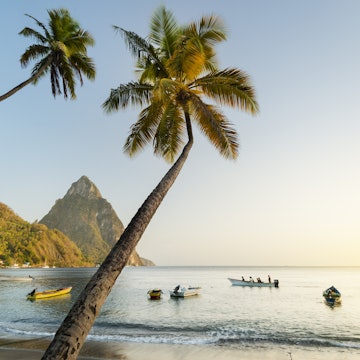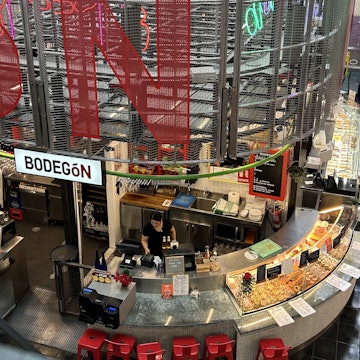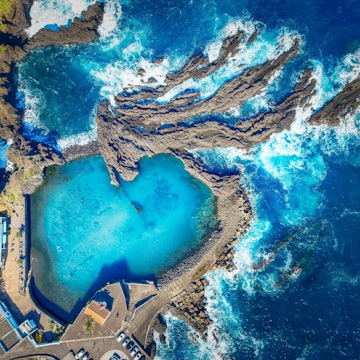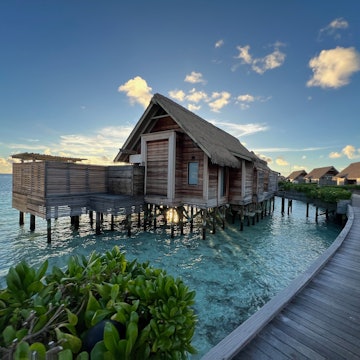

Santiago de Compostela with its UNESCO-listed historic center is the capital Galicia. imagoDens/Shutterstock
Ancient Romans called it the end of the earth, and Galicia still feels like a land apart. Tucked away in Spain's northwestern corner, this emerald region is packed with mist-shrouded mountains and valleys. Here, the Miño River carves through the landscape, meeting the Sil to form the wine-rich canyons of the Ribeira Sacra before marking the border with Portugal along its final stretch to the Atlantic.
In the Middle Ages, Santiago de Compostela became one of the three most important pilgrimage sites for Christianity, but there is much more to Galicia than the Camino. Here, the legacy of the Celts and Romans still survives in its inhabitants' culture, customs and traditions, visible in the extraordinary Torre de Hércules and the ancient walls of Lugo that still stand as testament to its ancient past.
Galicia's natural heritage is extraordinarily rich. You can hike all over the region, sail the rías (estuaries) to reach its unspoiled Atlantic Islands, surf in the Costa das Ondas and Costa da Morte or visit incredible natural sites like Praia As Catedrais, a beach where waves and wind have sculpted stone into soaring cathedral-like arches.
Here's how to explore Galicia.

When should I go to Galicia?
The high season from mid-May through mid-September offers a respite from the region's characteristic rain, allowing visitors to fully embrace its spectacular coastline and mountains.
But if you want to connect with Galicia and its people, travel in the low season. Though many visitors rightfully love the riotous colors that ripple across the region during fall, I love to visit between mid-winter and early spring when the landscape gradually comes back to life and the days lengthen.
In the low season, there are fewer visitors, prices are more affordable and you can participate in several festivals, such as the Entroido (Galician carnival), between mid-February and March. The longest and most renowned celebration takes place in Xinzo de Limia but it’s popular all over the region with flashy mask parades, comparsas (musical groups in costumes), lots of food, drink and fun!

How much time should I spend in Galicia?
Given Galicia's extensive natural and cultural heritage, good public transport connections, and wide variety of hiking trails, you'd need to allow at least two weeks to tour the region in depth. However, you can experience many of the top things to do in Galicia in a week, including a couple of day hikes in its natural parks.
For a long weekend, focus on one province. In A Coruña province, start in Santiago de Compostela's medieval streets and cathedral, then to the coastal city of A Coruña where the Tower of Hercules stands sentinel over the Atlantic. Drive to Fisterra - once believed to be the end of the world – where pilgrims traditionally end their Camino at sunset, before exploring the Celtic ruins perched on Castro de Baroña's rocky peninsula.
The province of Lugo offers its namesake city's complete circuit of Roman walls, the historic town of Mondoñedo, and the laidback port of Ribadeo, gateway to the natural wonder of Praia das Catedrais.
In Pontevedra province, begin in vibrant Vigo, Galicia's largest city, before taking a boat to the paradise-like Cíes Islands. Next, visit Combarro's stone houses and granaries, then end in Vilagarcía de Arousa, heart of the Rías Baixas wine region, for seafood and Albariño wine.

Is it easy to get in and around Galicia?
All major cities in Galicia can be reached by bus and train from Madrid. The train is faster, taking between three and four hours, but the bus, although it takes twice as long, is more scenic. Alternatively, you can travel by train from Porto (Portugal) to Vigo or by bus to Vigo, Santiago de Compostela and A Coruña.
Smaller Galician cities and towns are only connected by bus; check timetables and prices at Monbus. Usually, only the final destination is indicated, so if you are traveling to a village, ask the driver and remember to request the stop one stage before your destination.
Consider doing a road or bike trip to make the most of your time in Galicia. Traveling by car or bicycle will give you more freedom and the opportunity to access secluded villages, beaches and remote vineyards.
Galicia has three airports: Santiago-Rosalía de Castro, A Coruña (Alvedro), and Vigo (Peinador). Of the three, Santiago airport affords the most international connections (London, Paris, Geneva and Basel), followed by A Coruña (London, Milan and Geneva). All three airports have public bus services to the center of each city.

Top things to do in Galicia
Climb up the world's only Roman lighthouse still in use
In A Coruña, the murmur of the waves crashing hard on the Gulf of Ártabro increases as you approach the UNESCO World Heritage Site, Torre de Hércules, the only Roman lighthouse in the world still in operation. Don't be fooled by its 18th-century neoclassical exterior cladding, the Roman structure is inside.
Originally known as the Farum Brigantium, it was built in the first century to guide ships to Brigantium’s port using an ingenious oil lamp system that reflected light onto a large parabolic mirror. As you climb the 234 steps, you can access some of the vaults on the three floors of the lighthouse, find in-depth information in English and some curiosities, such as why and when it was renamed “Torre de Hércules”.
At the top, take a deep breath of fresh air and relish the astounding views of Praia do Areal with the Crystal City in the background, The Compass Rose of the Celtic nations and the endless Atlantic.
Make your own Camino de Santiago
Santiago de Compostela's story began with the alleged discovery of St. James the Greater's remains in the 9th century, transforming this corner of Spain into a pilgrim's destination.
Devastated in the 10th century, the capital of Galicia was rebuilt over many years, hence the harmonious amalgam of civil and ecclesiastical buildings in Romanesque, Gothic and Baroque styles that embellish the Old Town of Santiago de Compostela.
The city’s flourishing cannot be understood without the Routes of the Way of St. James – both are inscribed on the UNESCO World Heritage List. For a better understanding of the history of the Camino and the city, and to get ideas of how to make your own St. James Way, visit the Museum of Pilgrimages and Santiago in Praza das Praterías.
Beside it is the grand Praza do Obradoiro, from where pilgrims gaze in jubilation and disbelief at the impressive (and opulent) Cathedral of Santiago de Compostela at the end of their Camino.
If you intend to walk any of the 10 routes of the St. James Way in whole or part, do plenty of research and carefully consider the various routes' distances and physical demands.


Stroll along the Roman Walls of bimillenary Lugo
Nowadays, the walled perimeter of more than 2km (1.2 miles) of the ancient provincial city of Lucus Augusti (present-day Lugo) is the best preserved of the entire Roman Empire. Built between the 3rd and 4th centuries CE, it has become the local’s favorite spot to stroll with privileged views over Lugo's old town.
Once you’ve walked the wall, visit the Domus do Mitreo, the remnants of a Roman pool by the Cathedral, and my favorite museum in the city: Casa dos Mosaicos. Here, you’ll find the remains of a Roman manor house with spectacular mosaics and frescoes. Entrance is free, including a guided tour.
In late June, the Arde Lucus festival commemorates the founding of the bimillenary city and you’ll be immersed in a monumental historical Roman recreation with more than 300 activities.
Taste the excellent wines of Ribeira Sacra
The Minho and Sil rivers meet at the border of the provinces of Lugo and Ourense. Here, in the interior of its steep canyons with unique climatic conditions, the Galician people have developed a vertiginous system of terraces for vine cultivation that, in some parts, verges on the vertical.
Some of the most charming villages of the Ribeira Sacra, such as Chantada or Castro Caldelas, can be visited by public transport from Lugo or Ourense, where you can go to the adegas (wine cellars) for a viño tasting or guided vineyard tour.
Alternatively, visit the Ribeira Sacra Wine Centre in Monforte de Lemos to enjoy a guided tour (in Spanish) with wine tasting for a small fee. Although the panels are in Spanish and Galician, information is available in English and French.
Spring and summer are the best seasons for outdoor activities in the Ribeira Sacra, including hiking and cycling, boat trips on the rivers, kayaking and canyoning.
Delve into Galicia’s Celtic history at a Castro
The Celts inhabited these lands for over a millennium in castros (fortified settlements) built in strategically elevated or difficult-to-access places, such as my favorite in Galicia, the Castro de Baroña.
This Castro is located on a rocky peninsula in the Ría de Muros y Noia and was inhabited between the first century BCE and the first century CE. To access this magical place, you’ll cross a centenary forest and a small sand isthmus.
Savor Galicia's sea and orchard flavors
Combarro is one of my favorite Galician villages. Located in the Ría de Pontevedra, this seaside town has the peculiarity of having around 60 hórreos (granite and wood raised granaries) from the 18th century – most of them in Rúa do Mar – that are key indicator of local livelihoods: fishing and farming.
When the weather is nice, I love to have lunch on the terrace of a traditional restaurant serving Galician specialties, such as polbo à feira (octopus seasoned with olive oil and paprika), mussel and chorizo empanada in corn dough, and Galician-style vieiras (scallops au gratin) accompanied by a glass of local Albariño wine.
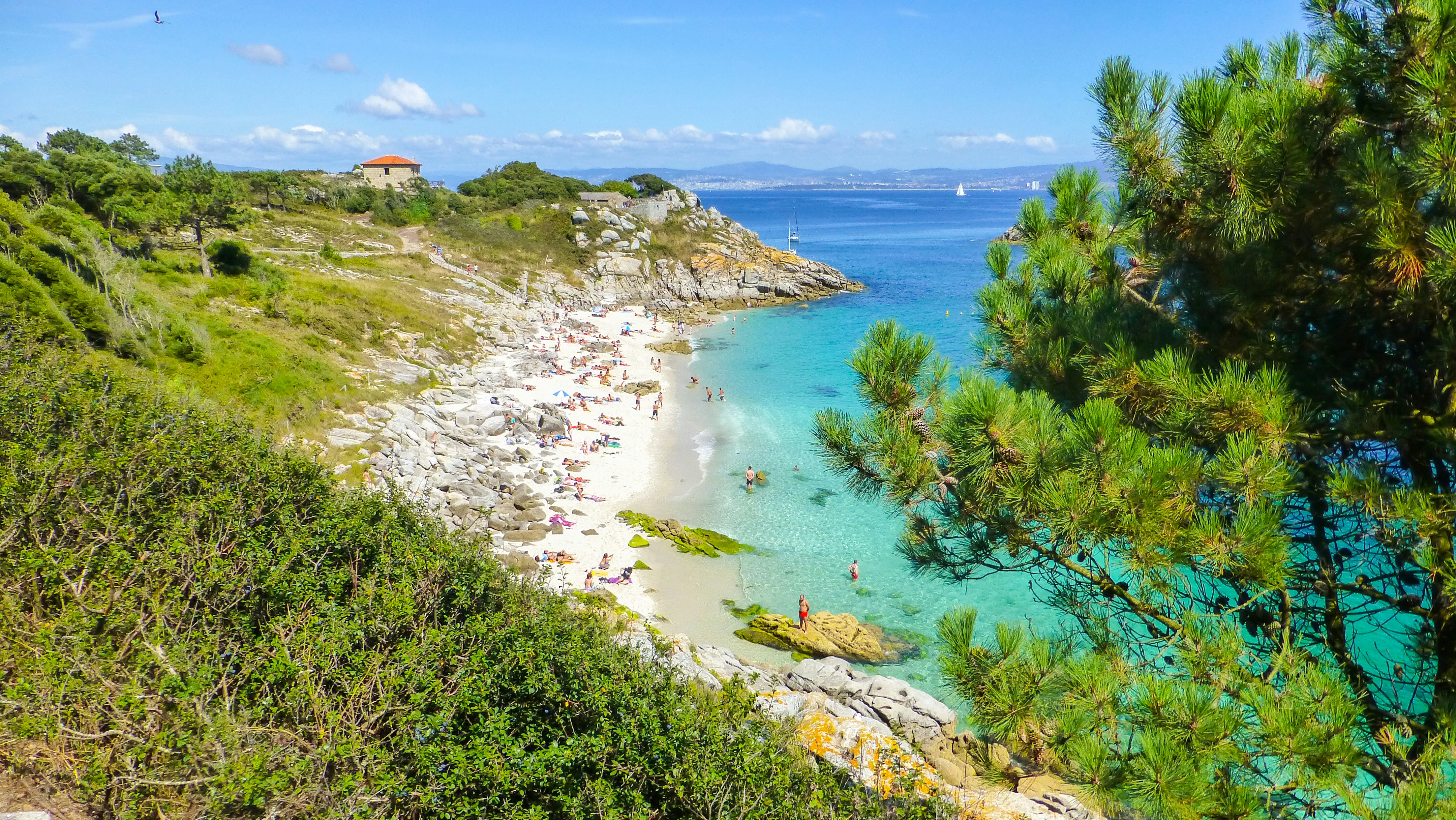
My favorite thing to do in Galicia
I love to visit the Cíes Islands during low season and walk barefoot on the fine pearly sand of the Praia de Rodas that connects Monteagudo and Faro islands, before settling down between them to enjoy a book amidst the crystalline waters of the Ría de Vigo.
Watching the yellow-legged gulls and great cormorants flying over the cliffs of the archipelago from the bird-watching cabin near the island's lighthouse is equally unforgettable.
The ecosystem of the Galician Atlantic Islands is unique and very fragile, and strict precautions exist to protect it. Authorization to visit is mandatory between May 15 and September 15. In low season, the navieras (shipping companies) will process the authorization for you, although you must take a short guided tour when you arrive at the archipelago.

How much money do I need for Galicia?
Overall, Galicia is good value for money regarding food and transportation. Most businesses, restaurants, bars, museums and attractions accept cards, except for some local buses in cities and towns – it’s advisable to carry change and €5 euro (US$5.22) bills.
Night at a downtown hotel: from €50 (US$52.54)
Night at a downtown hostel dorm: from €20 in low season and €30 in high season (US$20.88-31.34)
Prices for airport bus journeys: €1-2 (US$1.04-2.08)
Train ticket from Santiago de Compostela to A Coruña: €7.60 (US$7.94)
Return boat trip to the Cíes Islands: €20/€25, low season/high season (US$20.89/26.11)
Guided night visit to the Cathedral of Santiago de Compostela: €25 (US$26.11)
Ticket for Torres de Hércules: €3.09 (US$3.22)
Glass of Albariño wine: €3-6 (US$3.13 - $6.26)
Wine tasting in Ribeira Sacra vineyards: €15-40 (US$15.66-41.78)
Ración de Polbo á feira (portion of boiled octopus with potatoes): from €15 (US$15.66)
Slice of Tarta de Santiago: from €3 (US$3.13)
What language is spoken in Galicia?
Galician and Spanish share official status throughout the region. Galician, which shares Latin roots with French and Romanian, was linked with Portuguese until the 14th century. Today, Galician is still widely spoken in rural areas, fishing ports and traditional markets - you'll hear it most in coastal villages like Malpica and Muros, and inland farming communities around Lugo and Ourense. While Spanish is more prevalent in larger cities like Vigo and A Coruña, even here you'll find Galician used alongside it in daily life, from street signs to local newspapers.








